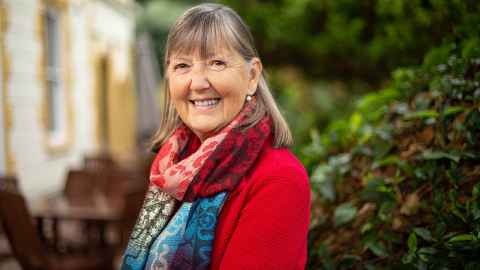Dr Disaster and the schools of tomorrow
31 May 2021
Carol Mutch says schools need more recognition and resources for their roles in the aftermath of increasingly common major disasters.



A principal from a school in Samoa describes a morning of terror: “The earthquake hit just after 7am. I was walking to school. I was about halfway there when I felt it. I started to run so I could get to school before anything happened. At the gate I saw the wave. Many children were already in the classrooms with their teachers. They saw me and started running towards me.
“I tried to signal for them to go the other way. I turned away from the school and started running up the hill and they started to follow me. Some were screaming. Some were crying. The tsunami caught the latecomers. It was very sad. We sat under a shaded tree and said a prayer.”
For the past decade, Mutch, Professor of Critical Studies in the Faculty of Education and Social Work at the University of Auckland, has listened to children and their teachers tell of the trauma, anxiety and fear they felt when their communities faced large-scale natural disasters from earthquakes and tsunamis to cyclones and bushfires.
These accounts have been the basis of her research into the specific burdens and responsibilities placed on students and teachers during and after major disasters, but more her research has helped those she works with understand what can often feel incomprehensible.
“I started with one principle. It’s important that we capture these stories and use the opportunity to help children and young people make sense of what has happened,” she says.
Mutch has a nickname in education circles: Dr Disaster. She’s visited schools following the Tōhoku earthquake and tsunami in 2011, which saw more than 18,000 people lose their lives. In Nepal, she worked with schools levelled by the Gorkha earthquake of April 2015 that took nearly 9,000 lives and injured thousands more.
In Australia, she has visited schools struggling to recover in the aftermath of bushfires that destroyed whole townships. When a disaster strikes in the world, often those in education circles will reach out to her and see if she can offer advice on response and recovery.
Her research and work began in the aftermath of the Christchurch quakes of 2011 that levelled much of the central city. For her, Christchurch was personal. At the time she worked for the Education Review Office (ERO), housed in an office building that collapsed in the February 22 quake. The memory remains stark.
“There’s a personal angle to this.” She could have been at her desk in that building if not for meetings in Wellington that day.
In her role at the ERO, she had been working with a number of schools. She wanted to see what support the schools she knew might need. As she talked with principals and teachers, it brought home to her how schools are so important but under-acknowledged in their role in rebuilding shattered communities.
“One of the first things Christchurch did was get the schools up and running. That’s sensible. It frees up adults to get on with the response and recovery, from getting services back to ensuring businesses can continue.”
Like doctors and nurses, the teachers were back at work. “But they were also victims. People had lost family, many had lost their homes or were living in places that had sustained major damage.”
A principal of a Christchurch school recalls their experience: “I was getting texts from my daughter, who is a nurse and was trapped in the hospital. My grandson was trapped at school and my schoolteacher husband couldn’t leave either. I couldn’t think of my family at the time and just had to assume they would be okay.”
Schools, already a community hub, became places of
safety and shelter. They are rally points for separated families and because schools often resume classes as a priority in the disaster responses, a reminder of the ordinary in extraordinary times.
In the first days following a major disaster, schools, often already a community hub, became places of safety and shelter for people who have lost their homes. They are rally points for separated families and because schools often resume classes as a priority in the disaster responses, a reminder of the ordinary in extraordinary times.
With funding from UNESCO and a new role at the Faculty of Education and Social Work at the University of Auckland in the School of Critical Studies, Mutch began to work formally and closely, developing ways to help the students and teachers find a new normal amid the devastation.
As a researcher, she was curious, and as an educator, she wanted to do more than conduct research. Her goal was to work with each school on a reciprocal project. “I’d ask them what they wanted. It might be a book or an artwork. The aim was to create a safe atmosphere where the children and teachers could talk about what had happened.” The technique, called emotional processing, originated in the United States.
As her research broadened, she was able to use the experiences she gathered and share them elsewhere. “So, in Cashmere in Christchurch we’d say, ‘We’ve been talking to our friends in Australia and their schools have just been through bushfires.’ And we’d ask them what they’d say to those kids about what earthquakes are like.”
The conversations sought to reframe the world-changing event and create a child’s perspective. This became a safe way to acknowledge what had happened, allowing children to form their own sense of the event, how they had felt and what they had done to help.
Repercussions echo
Sometimes it was about different ways to tell a story. One school said they wanted a community place of memory in an area set aside for a garden, so she worked with teachers and children on a mosaic, constructed from broken pieces of homes. It was their way to build something to remember the immediate aftermath of chaos. From the collected memories, the mosaic eventually became like a person. Children would stop by in their playtimes and talk with the mosaic like it was their friend.
An imaginary friend embodying real events. “Even when they left school, they would come back to say something or visit at anniversaries.” The artworks and garden became part of the community fabric and a symbol of how the community made their peace with what had happened. These storytelling projects could not be done quickly. They relied on building trust and co-authorship of stories in ways that felt right for those students and teachers.
Long after disasters leave the headlines, the impacts remain in communities. The immediate needs of food and shelter might be sorted, but the psychological and emotional repercussions continue to echo.
Mutch says that teachers and schools are well-versed in the drills and processes for the immediate response. But there is little to prepare them for the length of time it takes to return to a semblance of normality. Coping with broken buildings, problems with power and water and the ongoing stresses experienced by their school communities, teachers talked of the toll on their physical, emotional and psychological well-being.
A Christchurch school principal said: “We really had to look out for each other, be prepared and watch for signs: ‘This teacher is not going to be at school tomorrow. I can tell. She’s looking shaky."
Match’s research is the evidence to support advocacy for better acknowledgement of the role of schools, not only as hubs for effective, evidence-based first responders, but also their role in anchoring the community during the long path to recovery.
If we are to take anything from her work, Mutch says it is to support schools to have the tools to be ready to respond to major emergencies. Principals and teachers need training beyond emergency drills. There needs to be more professional development and collaboration with local agencies, from the Fire Service to the Red Cross. And there needs to be recognition and support for the ongoing role teachers and schools have in the welfare and well-being of their communities.
High workloads
Mutch is mindful that teachers and principals already manage high workloads. The last thing she wants is to add to that burden. Nor, she says, should that burden rest on their shoulders. The Government and ministries have a part to play, as does local government and Civil Defence.
“It’s a matter of your priority list. A major disaster right in your neighbourhood is low down on everyone’s priority list, until a tsunami strikes and you’re running for high ground. These things will happen, and with global warming and other factors, we will face more disasters, both natural and those caused by humans. The assessment needs to be made. Schools all have emergency management plans, but these need to be much more than a compliance exercise.”
As an educator, it is the children who are at the heart of the research. Often, children are regarded as passive and vulnerable. “I understand that. Our natural response is to keep children safe and protect them. That’s natural, but it’s not psychologically healthy.”
She refers to the global disaster of the Covid pandemic and how some parents have been reluctant to return their children to school. “We can’t blame them for their fear, but our research shows that kids could not wait to get back to school, to see their friends, to talk face to face and run around and laugh. They wanted to feel normal, and by doing that, it was allowing them to feel that the world was not completely out of control.”
Keeping children safe in three realms: physical, emotional and psychological
Professor Carol Mutch has guidance for how best school can serve their students in the immediate aftermath and long-term response to major disasters.
- While it is important to protect children’s safety and security, children also have the right to have a say in decisions made about them
- Most often adults make these decisions from a protective standpoint, treating children as passive and vulnerable.
- While some children will develop severe and long-term problems, many will recover within a reasonable time frame, given strategies and support
- Children need safe opportunities to process their experiences and absorb these into their personal histories
- Engaging collaboratively with others assists in their recovery
- They also need opportunities to participate in response and recovery activities appropriate to their capability
Story by Gilbert Wong
Researcher portrait by Elise Manahan
The Challenge is a continuing series from the University of Auckland about how researchers are helping to tackle some of the world's biggest challenges.
To republish this article please contact: gilbert.wong@auckland.ac.nz